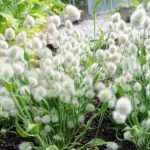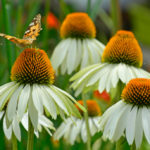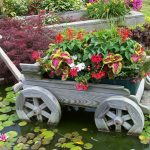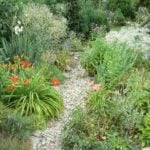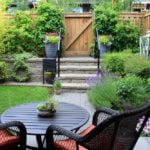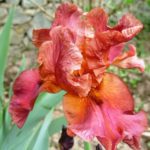Most flowering plants pleases us with their festive appearance is not so lasting. And the dream of probably every grower is to make the flower beds bright and elegant from the first spring days to late autumn, so that the time of flowering in the garden does not stop the whole season. The creation of flower beds of continuous flowering helps to realize this dream.
Non-obvious nuances
This flower bed has a number of significant features that must be taken into account when planning. And the first of the non-obvious nuances: the flowerbed of continuous flowering should be extensive. Why?
- To plants bloomed constantly, replacing each other, their range should be quite wide: a small number of species that will fit on a small flower bed, the problem can not be solved.
- The expressiveness of the flowerbed is given by large color spots; planting plants alone, you will not achieve the integrity of the composition — it will be fragmented, the abundance of small accents will distract attention, irritate the eye.

If the site does not allow you to plan an extensive area of the flower bed, the effect of continuous flowering is better to achieve at the expense of several small seasonal flower beds, considering their mutual location so that the overall picture of the garden always remains attractive.
The second non-obvious nuance: plants with similar flowering periods should be combined into groups instead of being distributed over the entire area of the flower beds. The reason is the same: scattered color spots will split the composition. As a rule, the plan of a flower bed of continuous flowering includes several seasonal groups, smoothly replacing each other: such a flower bed is always thoughtfully changeable.

Hence the third feature: the irregular nature of the flower beds, free planning. It is important to remember this, so as not to violate the overall style of the site: for example, if the landscape is dominated by straight lines and strict geometry, it is probably still better to break the planting of several seasonal flower beds, rather than trying to squeeze into a rigid framework of a bed of continuous flowering.
General rules for creating beds of continuous flowering
Start is, perhaps, with the “calendar of flowering”: select plants, noting the time during which each of them is the most attractive and decorative. At this stage, it is important to determine the range, taking into account, of course, the standard rules for the selection of plants for flower beds and flower beds:
- we combine only those plants that have similar or identical requirements for soil, nutrition, irrigation, illumination;
- we take into account the size of each plant, as well as the speed of its growth; do not forget that aggressive, rapidly growing crops will have to restrain, limit;
- selected and arranged plants based on their colors, combining — depending on his plan — a complementary or contrasting color.

Then we begin to draw a scheme or plan for the future flowerbeds. It is necessary to imagine very clearly how your flower garden will look at each of the seasonal time periods – literally by months. Do not forget: some plants (mostly spring bulbs, but not only) after flowering is losing appeal; that the bed won’t look messy when their leaves begin to wilt, it needs to cover the other grown by the time — decorative foliage plants or flowers, perhaps an annual.

Be sure to estimate the possible points of review: whether your flowerbed is available to viewers from all sides or you plan it one-sided. It depends on where and how to accommodate plants of different heights, so they do not block each other.
Care of plants is a complicated matter, so a large area should provide special areas or narrow paths, melirovannye (that is liberally sprinkled with) decorative materials: in them you will be able to reach any flower to be cut, watered or tie it if necessary.
Selection of plants
For beds of continuous flowering can be used as perennial and annual, and biennial plants. Moreover, the most rational is a bed of perennials, which is annually supplemented by colorful and long-flowering annuals. And of course, do not forget about the decorative deciduous crops and cereals: they are consistently decorative, and depending on the season can play a variety of roles in your composition.

Spring flowering plants
It is, first of all, a variety of bulbous. Here preference should be given to crops that do not require annual digging (tulips set aside for other flower beds) can be daffodils, crocuses, iridodictyum, Muscari, chionodoxa, puschkinia, scilla.
Of rhizomatous and tuberous perennials bloom in early spring, eranthis, hellebore, hepatica, caltha, corydalis, anemone, brunner. Of the biennial it is worth noting violas, or pansies, and daisies: they are attractive not only early flowering, but also its long duration.
Spring flowering perennials bloom behind melkolukovichnye, replacing them. Yellow trollius and doronicum, in the spring, veronica and iris, bergenia, a variety of primrose, phlox subulate — worthy decoration of the flower beds.

Deliberately did not indicate a specific time of flowering — they depend on the region and partly from the established plant conditions: how well warmed and lighted by the flower bed, what is her soil and so on. When in the South primroses are already wilting in the Middle lane may still be snow, but the General sequence of flowering is maintained, regardless of climate zone.
It is also reasonable to take into account that many plants, along with the early ones, have late species and varieties, combining which, you can noticeably prolong flowering. For example: astilbas can bloom, replacing each other, from the second half of June to the end of August; Phlox — from the end of June to the first frost; garden geraniums – from mid-may to September. Some crops (for example, delphiniums, lupins, bergenia and others) are able to bloom again with good care in late summer and early autumn.
Plants that bloom in summer
Their list is extremely extensive, it would be difficult to give it completely, so we will note only a part of them, which will come in handy on a bed of continuous flowering.

From perennials to the already mentioned astilbe, Phlox, garden geraniums, delphinium and lupine should be added leucanthemum, Lysimachia, lilies, monarda, eringium, hemerocallis, rudbeckia. Of course, you can not ignore the different types of carnations and bells (both biennial and perennial). Fans of ground cover plants will appreciate sedums, the flowering time of which also falls on the summer period.
And, of course, what a summer flower bed without bright annuals! Nearly always be relevant alyssum, lobelia, marigolds, zinnias. Lush flowering will please Snapdragons, summer varieties of asters, petunias, eschscholzia, portulaca oleracea. A spectacular vertical accent can be amaranth or sunflowers, decorative corn. Do not forget about such simple but elegant colors as nasturtium and pot marigold, in all the variety of their varieties.
Biennial plants, in addition to some species of campanula and dianthus, as well as, of course, viol and common daisy, are represented in this list by bright Foxglove and tall mallow.
You can easily continue this list depending on your own tastes and preferences.

Autumn flowering plants
These are, perhaps, primarily perennial and annual late asters and Queens of the autumn flower garden-chrysanthemums. Do not forget also tall sedum species (for example, hylotelephium spectabile), colchicum, helenium. As an original and effective border, you can use decorative cabbage, which frosts only benefit: with the onset of cold weather, its foliage becomes brighter and more contrasting. And luxurious tall cereals will not lose their beauty even under the first snow.

Luxury dahlias and ceremonial gladiolus for a flowerbed of continuous flowering is better not to use for the same reason as tulips: these plants require annual digging, and this must be done before the onset of frost, when other more cold-resistant plants are still blooming on the flowerbed. In addition, both Gladioluss and dahlias are quite thermophilic, that is, they should not be planted before the threat of spring cold weather passes, and these works can also disrupt the harmony of your composition. If you definitely want dahlias to bloom on the flower bed, stop your choice on annual varieties.





